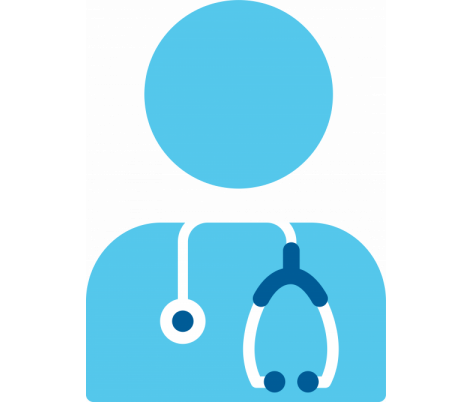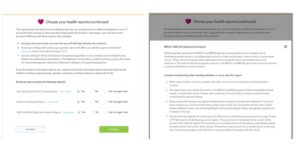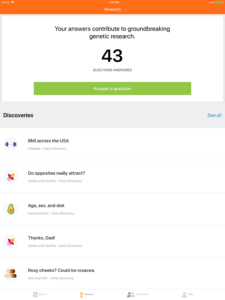
By Eloycsia Ratliff, MPH, 23andMe Medical Education Project Manager
Editor’s note: This is the second in an occasional series about 23andMe’s Medical Education program.
We sometimes hear misconceptions from healthcare professionals about what we do at 23andMe, especially when discussing our health reports. This post is meant to address the most common misunderstandings in hopes that we can provide some clarity and improve understanding of the 23andMe experience.
What are we testing?
At the DNA level, it’s estimated that the DNA of any two people is 99.5 percent identical, but it’s small differences that make us unique. These differences in our genome are called variants, and they can be linked to certain health conditions, traits, and ancestry groups. At 23andMe, we genotype DNA by extracting it from saliva samples — the DNA comes from white blood cells that are found naturally in the saliva and epithelial cells from the cheeks and mouth. Although genotyping doesn’t analyze an individual’s entire DNA sequence, it does allow us to look at about 600,000 DNA variants, which power our reports.
The variants included in 23andMe’s test are used in reports, not just on traits such as your likelihood of having a widow’s peak or about ancestry, but to estimate genetic risks for certain health conditions that are part of 23andMe Genetic Health Risk reports, which includes reports authorized by the FDA.*
How accurate are our reports?
23andMe is the first and only direct-to-consumer genetic testing service that includes reports authorized by the FDA. As part of that authorization process, 23andMe demonstrated analytical validity of the genotyping platform (accuracy in detecting a genetic variant) by achieving greater than 99 percent concordance when compared to Sanger sequencing, considered the gold standard for accuracy. In addition, the requirements for demonstrating clinical validity (well-established association between variant and the condition) were met.
What are the limitations of 23andMe’s Carrier Status and Genetic Health Risk Reports*
As with most tests, there are limitations specific to each report that are clearly stated within the customer’s results.
 There can be thousands of variants associated with a specific health condition and our report may only look at some of the more common variants, meaning if someone has one of the variants not tested, they could still be at increased genetic risk for the condition. For example, there are more than a thousand variants in the BRCA1 and BRCA2 genes associated with an increased risk for certain cancers, but 23andMe’s BRCA1/BRCA2 (Selected Variants) Genetic Health Risk* report looks at just three of these variants. And these variants are most commonly found in people with Ashkenazi Jewish ancestry. For individuals who find out they have one of these three variants, which can significantly increase their risk for cancer, this information can be extremely impactful when shared with their providers. But for customers who do not carry one of these variants, it’s important that they understand that they may still have a variant not tested. In addition, reports don’t account for family history, environment, and lifestyle which can also influence overall risk. 23andMe Genetic Health Risk reports state that not having a variant covered by our test does not mean someone is without risk.
There can be thousands of variants associated with a specific health condition and our report may only look at some of the more common variants, meaning if someone has one of the variants not tested, they could still be at increased genetic risk for the condition. For example, there are more than a thousand variants in the BRCA1 and BRCA2 genes associated with an increased risk for certain cancers, but 23andMe’s BRCA1/BRCA2 (Selected Variants) Genetic Health Risk* report looks at just three of these variants. And these variants are most commonly found in people with Ashkenazi Jewish ancestry. For individuals who find out they have one of these three variants, which can significantly increase their risk for cancer, this information can be extremely impactful when shared with their providers. But for customers who do not carry one of these variants, it’s important that they understand that they may still have a variant not tested. In addition, reports don’t account for family history, environment, and lifestyle which can also influence overall risk. 23andMe Genetic Health Risk reports state that not having a variant covered by our test does not mean someone is without risk.
23andMe highlights the intended use, limitations, and relevant ethnicities in Genetic Health Risk and Carrier Status reports. In addition, we have conducted user comprehension studies to ensure that our consumer can understand our Genetic Health Risk and Carrier Status reports.
If a 23andMe customer shows his or her healthcare provider their report, this information can be found in the report overview under the “How to Use this Test” section. As always, we encourage our customers (your patients) to consult with their healthcare provider.
How much control do customers have?
At 23andMe, our customers decide for themselves whether to view their health reports.
But before making that decision, we want to ensure our customers understand what they’ll be viewing. To do this, we’ve created multiple steps in the process that requires customers to manually select what information they want to view and what information they want to share. In addition, customers viewing their health reports must undergo specific tutorials to help them understand the key concepts presented in their reports.
For our “sensitive reports,” which are linked to more serious health conditions like late-onset Alzheimer’s* and Parkinson’s disease*, customers must additionally opt-in to viewing those specific results. This manual process must be done for every “sensitive” report that is launched.
Now, let’s talk about research!
While we believe participating in research can contribute to some promising breakthroughs in medical research, we want our customers to make that powerful choice for themselves.
All 23andMe customers who want to participate in research must undergo our informed consent process, which requires a customer to manually click “Yes” to participate. Without a customer’s consent, 23andMe cannot use their data for research. 
Data used for 23andMe research is de-identified and used in aggregate with other anonymous data. Customers participating in research can opt-out at any time, but most of 23andMe’s customers want to participate. More than 80 percent have opted-in to 23andMe research. Their contributions have led to the development of additional reports such as our Type 2 Diabetes Health Predisposition** report released in March, and the publication of more than 130 papers in peer-reviewed journals. Again, our customers are in the power seat, and they tell us where they want their data to go and what they want to see. It is their experience!
To help understand our reports and overall consumer experience, healthcare professionals can visit our website for healthcare professionals, medical.23andme.com. The site includes sample reports with various result outcomes. Additionally, you can find webinars and on-demand report walkthroughs led by our product scientists and genetic counselors. Our latest report walkthrough highlights our MUTYH- Associated Polyposis Genetic Health Risk report* released in May. We understand the need for this information and want to make sure you aware of the resources available to you.
*The 23andMe PGS test includes health predisposition and carrier status reports. Health predisposition reports include both reports that meet US FDA requirements for genetic health risks and the 23andMe Type 2 Diabetes health predisposition report which is based on 23andMe research and has not been reviewed by the FDA. The test uses qualitative genotyping to detect select clinically relevant variants in the genomic DNA of adults from saliva for the purpose of reporting and interpreting genetic health risks and reporting carrier status. It is not intended to diagnose any disease. Your ethnicity may affect the relevance of each report and how your genetic health risk results are interpreted. Each genetic health risk report describes if a person has variants associated with a higher risk of developing a disease, but does not describe a person’s overall risk of developing the disease. The test is not intended to tell you anything about your current state of health, or to be used to make medical decisions, including whether or not you should take a medication, how much of a medication you should take, or determine any treatment. Our carrier status reports can be used to determine carrier status, but cannot determine if you have two copies of any genetic variant. These carrier reports are not intended to tell you anything about your risk for developing a disease in the future, the health of your fetus, or your newborn child’s risk of developing a particular disease later in life. For certain conditions, we provide a single report that includes information on both carrier status and genetic health risk. Warnings & Limitations: The 23andMe PGS Genetic Health Risk Report for BRCA1/BRCA2 (Selected Variants) is indicated for reporting of the 185delAG and 5382insC variants in the BRCA1 gene and the 6174delT variant in the BRCA2 gene. The report describes if a woman is at increased risk of developing breast and ovarian cancer, and if a man is at increased risk of developing breast cancer or may be at increased risk of developing prostate cancer. The three variants included in this report are most common in people of Ashkenazi Jewish descent and do not represent the majority of BRCA1/BRCA2 variants in the general population. The MUTYH-Associated Polyposis Genetic Health Risk Report is indicated for reporting the Y179C and G396D variants in the MUTYH gene and an increased risk for colorectal cancer. The two variants included in this report are most common in people of Northern European descent. These reports do not include variants in other genes linked to hereditary cancers and the absence of variants included in these reports do not rule out the presence of other genetic variants that may impact cancer risk. The PGS test is not a substitute for visits to a healthcare professional for recommended screenings or appropriate follow-up. Results should be confirmed in a clinical setting before taking any medical action. For important information and limitations regarding other genetic health risk reports and carrier status reports, visit https://www.23andme.com/test-info.
**The 23andMe Type 2 Diabetes report is based on 23andMe research and incorporates more than 1,000 genetic variants to provide information on the likelihood of developing type 2 diabetes. The report does not account for lifestyle or family history and has not been reviewed by the US Food and Drug Administration. Visit 23andMe’s Type 2 Diabetes landing page for additional important information.